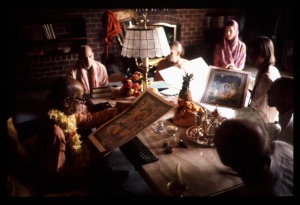CC Antya 18.98: Difference between revisions
m (1 revision(s)) |
No edit summary |
||
| Line 1: | Line 1: | ||
{{ | [[Category:Sri Caitanya-caritamrta - Antya-lila Chapter 18|C098]] | ||
<div style="float:left">'''[[Sri Caitanya-caritamrta|Śrī Caitanya-caritāmṛta]] - [[CC Antya|Antya-līlā]] - [[CC Antya 18|Chapter 18: Rescuing the Lord from the Sea]]'''</div> | |||
<div style="float:right">[[File:Go-previous.png|link=CC Antya 18.97|Antya-līlā 18.97]] '''[[CC Antya 18.97|Antya-līlā 18.97]] - [[CC Antya 18.99|Antya-līlā 18.99]]''' [[File:Go-next.png|link=CC Antya 18.99|Antya-līlā 18.99]]</div> | |||
{{CompareVersions|CC|Antya 18.98|CC 1975|CC 1996}} | |||
{{RandomImage}} | |||
==== TEXT 98 ==== | ==== TEXT 98 ==== | ||
<div | <div class="verse"> | ||
mitrera mitra saha-vāsī, cakravāke luṭe | :mitrera mitra saha-vāsī, cakravāke luṭe āsi', | ||
kṛṣṇera rājye aiche vyavahāra | :kṛṣṇera rājye aiche vyavahāra | ||
aparicita śatrura mitra, rākhe utpala,—e baḍa citra, | :aparicita śatrura mitra, rākhe utpala,—e baḍa citra, | ||
ei baḍa | :ei baḍa 'virodha-alaṅkāra' | ||
</div> | </div> | ||
| Line 14: | Line 18: | ||
==== SYNONYMS ==== | ==== SYNONYMS ==== | ||
<div | <div class="synonyms"> | ||
''mitrera''—of the sun-god; ''mitra''—the friend; ''saha-vāsī''—living together with the ''cakravāka'' birds; ''cakravāke''—the ''cakravāka'' birds; ''luṭe''—plunder; ''āsi'''—coming; ''kṛṣṇera rājye''—in the kingdom of Kṛṣṇa; ''aiche''—such; ''vyavahāra''—behavior; ''aparicita''—unacquainted; ''śatrura mitra''—the friend of the enemy; ''rākhe''—protects; ''utpala''—the red lotus flower; ''e''—this; ''baḍa citra''—very wonderful; ''ei''—this; ''baḍa''—great; ''virodha''-''alaṅkāra''—metaphor of contradiction. | |||
</div> | </div> | ||
| Line 21: | Line 25: | ||
==== TRANSLATION ==== | ==== TRANSLATION ==== | ||
<div | <div class="translation"> | ||
"The blue lotuses are friends of the sun-god, and though they all live together, the blue lotuses plunder the cakravākas. The red lotuses, however, blossom at night and are therefore strangers or enemies to the cakravākas. Yet in Kṛṣṇa's pastimes the red lotuses, which are the hands of the gopīs, protect their cakravāka breasts. This is a metaphor of contradiction." | |||
</div> | </div> | ||
| Line 28: | Line 32: | ||
==== PURPORT ==== | ==== PURPORT ==== | ||
<div | <div class="purport"> | ||
Because the blue lotus flower blossoms with the rising of the sun, the sun is the friend of the blue lotus. The cakravāka birds also appear when the sun rises, and therefore the cakravākas and blue lotuses meet. Although the blue lotus is a friend of the sun, in | Because the blue lotus flower blossoms with the rising of the sun, the sun is the friend of the blue lotus. The ''cakravāka'' birds also appear when the sun rises, and therefore the ''cakravākas'' and blue lotuses meet. Although the blue lotus is a friend of the sun, in Kṛṣṇa's pastimes it nevertheless plunders their mutual friend the ''cakravāka''. Normally, ''cakravākas'' move about whereas lotuses stand still, but herein Kṛṣṇa's hands, which are compared to blue lotuses, attack the breasts of the ''gopīs'', which are compared to ''cakravākas''. This is called a reverse analogy. At night the red lotus blossoms, whereas in sunlight it closes. Therefore the red lotus is an enemy of the sun and is unknown to the sun's friend the ''cakravāka''. The ''gopīs''' breasts, however, are compared to ''cakravākas'' and their hands to red lotuses protecting them. This is a wonderful instance of reverse analogy. | ||
</div> | </div> | ||
__NOTOC__ | |||
<div style="float:right; clear:both;">[[File:Go-previous.png|link=CC Antya 18.97|Antya-līlā 18.97]] '''[[CC Antya 18.97|Antya-līlā 18.97]] - [[CC Antya 18.99|Antya-līlā 18.99]]''' [[File:Go-next.png|link=CC Antya 18.99|Antya-līlā 18.99]]</div> | |||
__NOTOC__ | |||
__NOEDITSECTION__ | |||
Revision as of 05:49, 25 September 2021

A.C. Bhaktivedanta Swami Prabhupada
TEXT 98
- mitrera mitra saha-vāsī, cakravāke luṭe āsi',
- kṛṣṇera rājye aiche vyavahāra
- aparicita śatrura mitra, rākhe utpala,—e baḍa citra,
- ei baḍa 'virodha-alaṅkāra'
SYNONYMS
mitrera—of the sun-god; mitra—the friend; saha-vāsī—living together with the cakravāka birds; cakravāke—the cakravāka birds; luṭe—plunder; āsi'—coming; kṛṣṇera rājye—in the kingdom of Kṛṣṇa; aiche—such; vyavahāra—behavior; aparicita—unacquainted; śatrura mitra—the friend of the enemy; rākhe—protects; utpala—the red lotus flower; e—this; baḍa citra—very wonderful; ei—this; baḍa—great; virodha-alaṅkāra—metaphor of contradiction.
TRANSLATION
"The blue lotuses are friends of the sun-god, and though they all live together, the blue lotuses plunder the cakravākas. The red lotuses, however, blossom at night and are therefore strangers or enemies to the cakravākas. Yet in Kṛṣṇa's pastimes the red lotuses, which are the hands of the gopīs, protect their cakravāka breasts. This is a metaphor of contradiction."
PURPORT
Because the blue lotus flower blossoms with the rising of the sun, the sun is the friend of the blue lotus. The cakravāka birds also appear when the sun rises, and therefore the cakravākas and blue lotuses meet. Although the blue lotus is a friend of the sun, in Kṛṣṇa's pastimes it nevertheless plunders their mutual friend the cakravāka. Normally, cakravākas move about whereas lotuses stand still, but herein Kṛṣṇa's hands, which are compared to blue lotuses, attack the breasts of the gopīs, which are compared to cakravākas. This is called a reverse analogy. At night the red lotus blossoms, whereas in sunlight it closes. Therefore the red lotus is an enemy of the sun and is unknown to the sun's friend the cakravāka. The gopīs' breasts, however, are compared to cakravākas and their hands to red lotuses protecting them. This is a wonderful instance of reverse analogy.